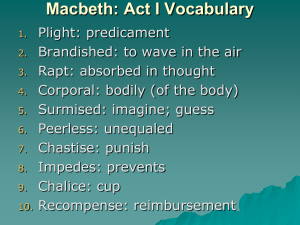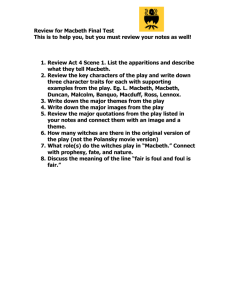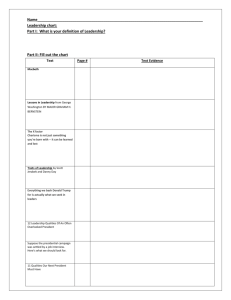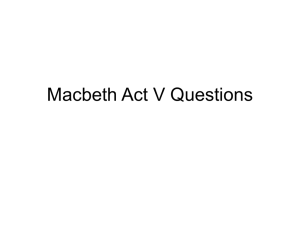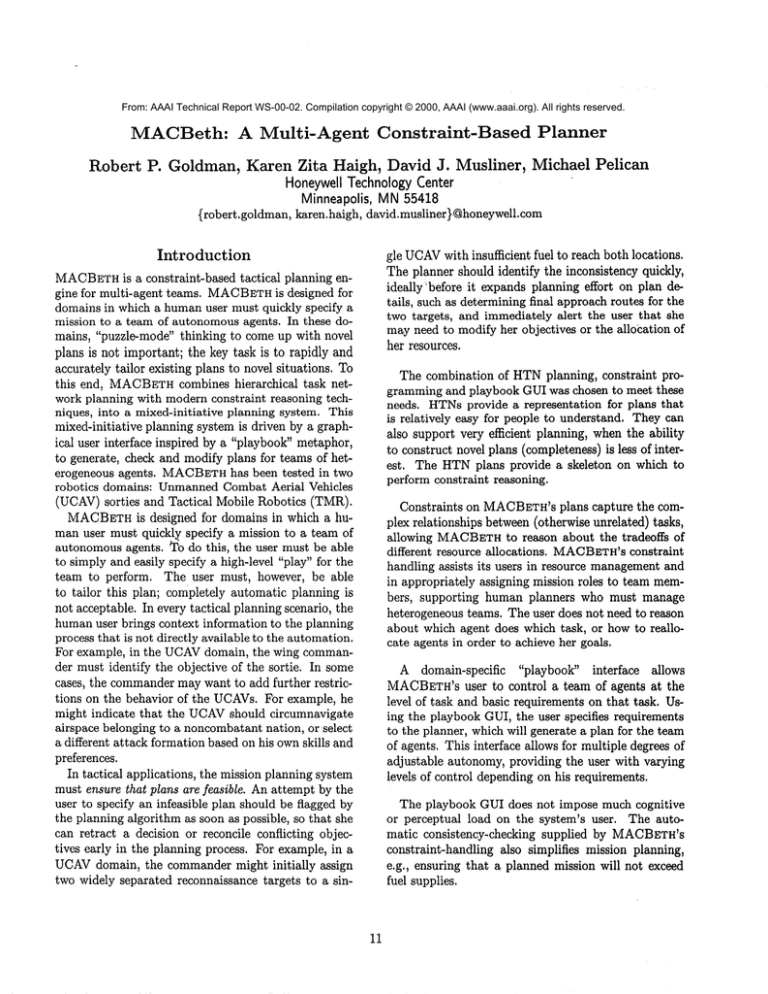
From: AAAI Technical Report WS-00-02. Compilation copyright © 2000, AAAI (www.aaai.org). All rights reserved.
MACBeth:
A Multi-Agent
Constraint-Based
Robert P. Goldman, Karen Zita Haigh, David J. Musliner,
HoneywellTechnology
Center
{robert.goldman,
Planner
Michael Pelican
Minneapolis, MN 55418
karen.haigh, david.musliner}~honeywell.com
Introduction
gle UCAV
with insufficient fuel to reach both locations.
The planner should identify the inconsistency quickly,
ideallybefore it expands planning effort on plan details, such as determining final approach routes for the
two targets, and immediately alert the user that she
mayneed to modify her objectives or the allocation of
her resources.
MACBETH
is a constraint-based tactical planning engine for multi-agent teams. MACBETH
is designed for
domains in which a human user must quickly specify a
mission to a team of autonomous agents. In these domains, "puzzle-mode" thinking to come up with novel
plans is not important; the key task is to rapidly and
accurately tailor existing plans to novel situations. To
this end, MACBETH
combines hierarchical
task network planning with modern constraint reasoning techniques, into a mixed-initiative planning system. This
mixed-initiative planning system is driven by a graphical user interface inspired by a "playbook" metaphor,
to generate, check and modify plans for teams of heterogeneous agents. MACBETH
has been tested in two
robotics domains: UnmannedCombat Aerial Vehicles
(UCAV)sorties and Tactical Mobile Robotics (TMR).
MACBETH
is designed for domains in which a human user must quickly, specify a mission to a team of
autonomous agents. To do this, the user must be able
to simply and easily specify a high-level "play" for the
team to perform. The user must, however, be able
to tailor this plan; completely automatic planning is
not acceptable. In every tactical planning scenario, the
humanuser brings context information to the planning
process that is not directly available to the automation.
For example, in the UCAVdomain, the wing commander must identify the objective of the sortie. In some
cases, the commandermay want to add further restrictions on the behavior of the UCAVs.For example, he
might indicate that the UCAVshould circumnavigate
airspace belonging to a noncombatant nation, or select
a different attack formation based on his ownskills and
preferences.
In tactical applications, the mission planning system
must ensure that plans are feasible. An attempt by the
user to specify an infeasible plan should be flagged by
the planning algorithm as soon as possible, so that she
can retract a decision or reconcile conflicting objectives early in the planning process. For example, in a
UCAVdomain, the commander might initially
assign
two widely separated reconnaissance targets to a sin-
The combination of HTNplanning, constraint programming and playbook GUI was chosen to meet these
needs. HTNsprovide a representation for plans that
is relatively easy for people to understand. They can
also support very efficient planning, when the ability
to construct novel plans (completeness) is less of interest. The HTNplans provide a skeleton on which to
perform constraint reasoning.
Constraints on MACBETH’s
plans capture the complex relationships between (otherwise unrelated) tasks,
allowing MACBETH
to reason about the tradeoffs of
different resource allocations. MACBETH’s
constraint
handling assists its users in resource managementand
in appropriately assigning mission roles to team members, supporting human planners who must manage
heterogeneous teams. The user does not need to reason
about which agent does which task, or how to reallocate agents in order to achieve her goals.
A domain-specific
"playbook" interface
allows
MACBETH’s
user to control a team of agents at the
level of task and basic requirements on that task. Using the playbook GUI, the user specifies requirements
to the planner, which will generate a plan for the team
of agents. This interface allows for multiple degrees of
adjustable autonomy, providing the user with varying
levels of control depending on his requirements.
The playbook GUI does not impose much cognitive
or perceptual load on the system’s user. The automatic consistency-checking
supplied by MACBETH’s
constraint-handling also simplifies mission planning,
e.g., ensuring that a planned mission will not exceed
fuel supplies.
11
nodes in the initial network(e.g., fuel supply is 10,000
gallons). Methoddefinitions specify the constraints to
be created when the operator is instantiated.
Constraints can be specified between tasks and their parents in the abstraction hierarchy, their siblings, and
their children, or on the values of their parameters
(perhaps as related to the parameters of their parents,
siblings, or parents). For example, the fuel used during
the ingress phase of a aircraft sortie will be greater than
or equal to the sum of the fuel used by its children. In
Figure 1 we graphically indicate temporal precedence
constraints.
Figure 1: A hierarchical task decomposition for a
UCAVdomain. Ovals represent
andnodes; rectangles represent or-nodes.
Playbook GUI and User Constraints
The task model is designed to enable easy intuitive
human control. This representation allows us to develop a playbook GUI(Miller & Goldman1997), a natural way for the humanto interact with the planner.
The playbook concept was influenced by sports playbooks, where each player knows the broad outline of a
"play", and each play has been well-practiced by the
team. During an actual game, the play is "tailored" by
a coach or team captain to meet the conditions on the
field.
In the’MACBETH
paradigm, "calling a play" means
that the humanuser (analogous to the coach) declares
that a certain task needs to be accomplished. The
user can "tailor" the play by adding constraints and
requirements specified by operating conditions. Tailoring a plan essentially allows for adjustable autonomy
on the robots. In this manner, the user can task automation subsystems to behave appropriately for the
performance of that task.
As the planner expands the plan, it displays the consequences of planning decisions to the user, who can
retract previous choices, or make better-informed decisions about available choices.
A playbook GUI should be designed to allow different levels of control depending on the domain, task
and the target user. As the user’s knowledgeand skills
decrease, the robot’s autonomy needs to increase. In
TMR,the target user is a soldier squad leader or robot
operator within a squad. The plays contain internal
timing constraints, and certain actions (e.g. take
photo) have related hardware requirements. Most remaining constraints are map- or environment-related,
including for example navigation waypoints and goal
locations (specified by the user) and required locomotion capabilities (specified by the route planner).
Figure 2 shows a sample playbook GUIfor the TMI:L
domain. In the upper left corner, the GUI displays
the list of available plays. In the lower left corner,
the GUIshows status information for a selected robot.
The right hand side displays the map, the home base
Mission
Task Model
We use Hierarchical
Task Networks(HTNs) as the
framework to encode, track and dynamically modify
the plans, goals, tasks and objectives specified by humans. HTNs provide a number of advantages: They
provide a representation that is relatively understandable by humanusers, for mixed-initiative planning. Although in the worst case, HTNplanning is more difficult than, e.g., STRIPSplanning (Erol, Hendler, &Nau
1994a), in practice it is often more efficient (Wilkins
1988), as in our application. Also, unlike "first principles" planners, which choose actions based on their
effects, HTNsmake it easy to specify actions to be
done, or goals to be achieved "just because" -- e.g., in
this case I knowthat taking an aspirin is a good thing
to do, although I don’t have a good model of the effects
of the action. Most important for this discussion, the
HTNsprovide a structure for encoding constraints and
incorporating them as appropriate.
In Hierarchical Task Network (or "decomposition")
planning, the problem is to flesh out a sketchy plan
for the planning problem, rather than to build a path
from an initial state to some memberof a goal state
set. Part of an HTNfor the UCAVdomain is shown
in Figure 1. In the initial state of an HTNplanning
problem, one has a task network that specifies only the
goal to be achieved; in the example of Figure 1, say a
network with only a "Mission" node. The problem is
to build a full tree downfrom the initial node through
"methods" and "goals." Methods (or operators) are
AND nodes that provide a means of achieving some
goal, in terms of a set of steps (or sub-goals). E.g.,
to perform a "Lethal SEAD"mission, you must first
"Ingress," then "Strike" and finally "Egress." Goals
are oR nodes that specify a set of methods that are
applicable. For example, one can perform "Ingress"
flying in formation or dispersed.
The problem of HTNplanning is one of constrained
AND/OR tree search. Constraints may be attached to
12
Figure 2: Playbook GUI for a TMRdeployment domain.
(triangle), the robots’ current locations (filled circles),
and the robots’ goal locations (clear circles). When
the user selects a play, he can then either (1) click
Execute, and MACBETH
will generate and execute a
plan, or (2) click Tailor, and MACBETH
will generate
a (constraint-free) plan, and then allow the user to set
constraints and otherwise tailor the play to the current
situation, executing the (constrained) plan only after
the user clicks Execute.
The TMRGUI was written in Java for operation
inside a web browser. The UCAVGUI was written using Tcl/Tk and the daVinci graph visualization
tool (Frohlich & Werner 1997).
MACBETH
differs from existing "strategic"
planning systems in that decomposition and method choice
is not the primary focus of the planning activity.
Strategic planning systems (e.g. (Georgeff & Lansky
1987; Nourbakhsh 1997; Veloso et al. 1995)), on the
other hand, typically construct plans based on a study
of the preconditions and effects of actions, and hence
may construct plans whose steps are not well-known
to the user. Instead of focusing on such "puzzle-mode"
thinking, which is not appropriate in the tactical setting, MACBETH
focuses on handling the complex constraints needed to manage resources such as fuel, to
follow communications doctrine, to synchronize multiple agents, and to influence role assignments. Previous planning systems, even constraint-centered planners like O-PLAN2(Bienkowski & desJardins 1994;
Pell et al. 1997; Tate, Drabble, &Dalton 1994), do not
incorporate modern constraint-solving techniques, and
few are easy to integrate with special-purpose solvers.
MACBETH Planning
MACBETH
uses Hierarchical
Task Network (HTN)
planning (Erol, Hendler, & Nau 1994b; Wilkins 1988)
and constraint logic programming techniques (Jaffar
Michaylov 1987; Hentenryck 1989) to generate mission plans that meet specifications provided by a human user. MACBETH
analyzes the user’s specifications for feasibility, and automatically generates mission plans consistent with the user’s requirements and
restrictions.
MACBETH
will also prefer optimal plans
when multiple alternatives are consistent and feasible.
The design of the mission task model ensures that
the broad outline structure of a mission is knownbefore the planning has begun. MACBETH’s
job is to
assist the user by managing the resources, deadlines,
and constraints between alternative actions during the
development of the plan. The planner represents these
limited quantities as constraints on and between individual plan operators, and manages them with an
internal constraint managementengine.
On the other hand, constraint programming provides a unifying framework in which to address problems like resource management, synchronization, etc.,
but does not provide a convenient way of specifying
such problems. The HTN planning framework provides a representation that enables MACBETH
to systematically compose hybrid constraint problems that
integrate resource management, role assignment and
method choice.
Combining HTNplanning and constraint propagation provides an efficient way to specify a wide variety of problems. MACBETH
is implemented in SICStus Prolog, using Constraint Logic Programmingfor
Finite Domains (clp(FD)) to manage time and other
13
1resources.
Planning Process
MACBETH
uses HTNplanning to flesh out the highlevel (non-primitive) tasks in the plan. Wheneverthe
planner identifies a non-primitive task in the plan, it
decides whether the node can be decomposed by applying one or more methods to the task. In the case
that more than one method applies, the planner develops all of the alternative paths. Infeasible alternatives
are pruned from consideration.
At each step in the planning process, MACBETH
determines the feasibility of the current partially specified plan. As each task is expanded, constraints from
the corresponding method are added to the clp(FD)
constraint managementengine. As the plan is built,
constraints propagate both up, from sub-tasks to tasks,
and down, from tasks to their expansions. This constraint propagation process enables the planner to
quickly identify flaws in the plan. If some methods
for achieving a task do not meet the user-imposed mission constraints, then MACBETH
will eliminate those
methods from consideration.
For example, if there are two possible attack routes
for an aircraft, MACBETH
will verify that both routes
meet fuel and timing constraints. If both routes meet
all constraints, then MACBETH
will select the better
of the routes (based on some previously-specified evaluation criteria). If one route requires too muchfuel
or takes too long, then MACBETH
will eliminate that
route from consideration, selecting the feasible route. If
neither route meets the user’s constraints, then MACBETH
will tell the user that his plan is infeasible.
MACBETH
can also use constraint
management
techniques to manageresources that are widely separated in use, assuming that the constraints were specified in the task model. For example, in the TMRdomain, if one task requires a certain hardware capability, then the constraint store will keep track of which
robots could be assigned to that task. This kind of
constraint is automatically propagated throughout the
plan, allowing MACBETH
to effortlessly
detect complex resource interactions that most other planning
systems could only detect with difficulty.
For example, if a "guard" task requires a colour camera, and
robots Alpha and Beta both have colour cameras, then
MACBETH
will ensure that one of these two robots is
assigned to the "guard" task. If Beta is later assigned a
different, unrelated task, the MACBETH
will automatically assign Alpha to the "guard," with no additional
introspection or backtracking.
1Weexpect later to incorporate more flavors of CLPto
incorporate different kinds of resources, etc., but clp(FD)
is adequatefor our current applications.
14
Another benefit of the constraint management engine is that MACBETH
can easily coordinate different
tasks. If two different tasks need to be, say, initiated
at the same time, the designer can easily specify this
timing constraint.
During plan expansion, MACBETH
will bind the two start times together. Any variable
that affects the start time of either action will hence
affect the start time of both actions. Each time such
a variable is modified, MACBeth’sconstraint engine
will propagate the the effects throughout the plan. In
this way, for example, two TMRrobots could easily be
instructed to enter a building from different doors at
exactly the same time. If one arrives at its door before
the other, then the first one will wait until the second
one is ready.
Table 1 outlines the planning process. The core of
MACBeth’sresource managementcapabilities lie in the
function instantiate_variables 0. Prolog’s variable unification mechanismallows constraints to flow throughout the tree as specified by the connections described
in the operators (lines 11 through 19). Note that for
an or-node, variables are copied rather than unified
with the value of the parent node (lines 16 and 17);
in this manner, MACBETH
can expand each method
individually without interference from other unrelated
methods. Whenthe user chooses between methods (or
MACBETH
selects one in preference to the others), the
constraints are propagated up to the parent and hence
through the rest of the tree. The clp(FD) constraint
managementengine then stores and keeps track of the
effect of constraints on the variables (lines 20 and 21).
The planner uses constraint propagation techniques
to manageresources, coordinate the individual plays,
to ensure that user-imposed constraints are met, and to
opportunistically prune regions of the plan space when
choices in one part of the plan force choices in another
part.
Wehave not constructed proofs of soundness and
completeness for the algorithm, but we believe it to
be so. The tree search in generate_plan_tree will be
sound and complete as handled by Prolog’s depth-firstsearch, and we have not added excess constraints that
to the clp(FD) engine that would prune any correct
plans. Note, however, that the planner may be viewed
as incomplete with respect to an understanding of its
domain, because the domain knowledge engineer may
force certain parameter choices to be made by the user.
For example, the knowledge engineer in the UCAV
domain stipulated that the user must specify the target
of an airstrike, rather than permitting the planner to
choose this location at its own discretion! User specifications are discussed in the following section.
1. generate_plan_tree(Node)
2.
if Node has mandatory, unbound variables
cannot expand node until value is specified by user
3.
4.
else if Node has available methods (Or-node)
5.
foreach available method,
6.
create a Child of Node for method
7.
instantiate_variables("or-node",
Child, Node
8.
generate_plan_tree(Child)
9.
else if Node has required steps (And-node)
foreach available step,
10.
create a Child of Node for step
11.
12.
instantiate_variables("and-node",
Child, Node
13.
generate_plan_tree(Child)
14.
else primitive operator
15. instantiate_variables(Type,
Child, Parent)
foreach variable in Parent to be passed to
16.
if Type is "or-node"
17.
Copy the Parent’s value to the Child’s
18.
else if Type is "and-node"
foreach variable in Parent to be passed to
Unify the Parent’s value to the Child’s
19.
20.
constrain any typed parameters in Child
21.
apply constraints specified in operator to variables of Child
Table 1" The core of MACBeth’splanning process.
Handling User Specifications
After every user action, MACBETH
incorporates the
user’s decision into the current plan. User actions
shape the direction of the evolving plan. User actions
fall into three classes:
Child,
value.
Child,
value.
3. The planner determines that there is not enough information available to expand this node (e.g., possible ingress formations cannot be determined until
the numberof aircraft is specified).
A final alternative is that the planner manages to
incorporate the user action successfully. Such success
can trigger considerable action by the planner:
1. specifying undefined variables,
2. choosing between alternative methods for task completion, and
3. introducing timing or ordering constraints.
1. The new constraints eliminate some choices for the
expansion of other nodes. This elimination may allow the planner to further expand that part of the
plan.
2. The new constraints sufficiently restrict the range of
a parameter so that another task in the network can
be expanded.
3. The expansion of the task creates new non-primitive
tasks that may be expandable.
4. A primitive (unexpandable) task is created.
By specifying the task parameters, the user shapes
the plan’s broad outline and identifies important task
characteristics.
Typical parameters provided by the
user include mission priorities,
available equipment,
and specific targets. By choosing between alternative
methods for task completion, the user can express a
preference between feasible plans. Finally, by introducing timing constraints the user can specify team
coordination, or a preferred sequence of tasks.
Whenthe planner reacts to a user action, there are
several possible outcomes. Twoare failures:
Some constraints
are mandatory; that is, MACBETHwill not execute a plan until the information has
been supplied. For example, the user must specify a
target location in the UCAVdomain.
Whenever a non-mandatory constraint has not been
supplied by the user, MACBETH
will assume it has
complete freedom of choice. For example, unless the
user specifies location to guard, MACBETH
will assume that the TMRrobots are free to explore unknown
space.
1. The planner cannot find an appropriate expansion.
The attempt to expand the plan fails.
2. The constraints on the new method violate existing
constraints (e.g., a methodrequires satelite communication between aircraft but no satelites are available in this region).
A third just indicates that the planner needs more assistance from the user:
15
Similarly, when there are multiple paths through the
plan tree (i.e. multiple possible methods or available
resources) that will accomplish the task and that meet
constraints,
MACBETH
will arbitrarily
select which
one to attempt. If a preference function has been supplied (e.g. select the shortest route, select the robot
with the most power), MACBETH
will select the preferred option.
As the user supplies more and more constraints, the
planner’s freedom is more and more reduced. Essentially, this relationship specifies degrees of adjustable
autonomy. At the highest level, the user needs to only
supply mandatory constraints.
MACBETH
will then
assume full autonomy, and generate a plan accordingly.
At an intermediate level (the lowest while still using the
playbook), the user specifies every constraint, including which of multiple alternative methods to select to
accomplisha task. The robots are still free to avoid obstacles and navigate between waypoints autonomously.
Finally, at the lowest level of robot control, the user can
tele-operate the robot, giving the robot no freedom at
all.
The planner currently only invokes the labeling process when the plan is to be completed. The labeling
process assigns values to those variables for which constraint propagation has not forced a choice. Variable
assignment maynot be forced either because the existing set of constraints does not dictate a single value for
the variable or because constraint propagation is incomplete. For the latter case, a co-process using labeling could provide further pruning of inconsistent plan
choices. Wehave not implemented this alternative because Prolog’s constraint propagation is complete for
the class of constraints we have used in our domains
(i.e., any value that is labeled as consistent is, in fact,
consistent).
straints on the plan, the route planning action will be
undone and removed from the plan tree.
Conclusions
MACBETH
combines HTN planning with constraint
propagation techniques. It provides support for a playbook GUI, through which human users can specify instructions
and constraints
on tasks. MACBETH
has
been used for a UCAVdomain and a TMRdomain.
For TMR, MACBETH
is part of a complete end-toend system, in which a human user uses a playbook
GUI to control a team of robots at Carnegie Mellon
University.
References
Bienkowski, M. A., and desJardins,
M.E. 1994.
Planning-based integrated decision support systems.
In Hammond,K., ed., Artificial Intelligence Planning’Systems: Proceedings of the Second International
Conference (AIPS-9~), 196-201. Chicago, IL: (Menlo
Park, CA: AAAIPress).
Erol, K.; Hendler, J.; and Nau, D. S. 1994a. HTN
planning: Complexity and expressivity. In Proceedings of the Twelfth National Conference on Artificial Intelligence,
1123-1128. Menlo Park, CA: AAAI
Press/MIT Press.
Erol, K.; Hendler, J.; and Nau, D. S. 1994b. UMCP:
A sound and complete procedure for hierarchical task
network planning. In Hammond,K. J., ed., Artificial Intelligence Planning Systems: Proceedings of the
Second International Conference, 249-254. Los Altos,
CA: Morgan Kaufmann Publishers, Inc.
Frohlich, M., and Werner, M. 1997. The daVinci
graph visualization tool. http://www.informatik.unibremen, de/" davinci.
Integration
With Specialized
Problem-Solvers
Georgeff, M. P., and Lansky, A. L. 1987. Reactive reasoning and planning. In Proceedings of th e National
Conference on Artificial Intelligence (AAAI-87), 677682.
The structure
of the MACBETH
planner provides
a straightforward way to incorporate special-purpose
problem solvers like a route planner. Whena problemsolver’s inputs can be mappedto plan operator parameters, and its interactions with other operators can be
described using constraints, it can be integrated with
MACBeth.
In the UCAVdomain, the route planner uses a dynamic programming algorithm to find a minimal altitude trajectory between two locations, that is, one that
results in minimal exposure to enemy radar and visual
detection. The resulting path determines the minimum
flight time and fuel requirements for the action, which
are posted as constraints on the plan. If the flight time
or fuel requirements of the action violate current con-
Hentenryck, P. V. 1989. Constraint Satisfaction in
Logic Programming. (Cambridge, MA:MIT Press).
Jaffar, J., and Michaylov, S. 1987. Methodology
and implementation of a CLP system. In Proceedings of the Fourth International Conference on Logic
Programming. (Cambridge, MA: MIT Press).
Miller, C., and Goldman, R. P. 1997. "tasking" interfaces; associates that knowwho’s the boss. In Proceedings of the Fourth HumanElectronic Crew Conference.
16
Nourbakhsh, I. 1997. Interleaving Planning and Execution for Autonomous Robots. (Dordrecht, Netherlands: Kluwer Academic). PhD thesis. Also available as technical report STAN-CS-TR-97-1593,Department of Computer Science, Stanford University,
Stanford, CA.
Pell, B.; Bernard, D. E.; Chien, S. A.; Gat, E.;
Muscettola, N.; Nayak, P. P.; Wagner, M. D.; and
Williams, B. C. 1997. An autonomous spacecraft
agent prototype. In Proceedings of the First International Conference on Autonomous Agents, 253-261.
Marina del R.ey, CA: (New York, NY: ACMPress).
Tate, A.; Drabble, B.; and Dalton, J. 1994. Reasoning with constraints within O-Plan2. In Burstein,
M. H., ed., ARPA/RomeLaboratory Knowledge-based
Planning and Scheduling Initiative, 99-109.
Veloso, M. M.; Carbonell, J.; P@rez, M. A.; Borrajo,
D.; Fink, E.; and Blythe, J. 1995. Integrating planning and learning: The PRODIGY
architecture.
Journal of Experimental and Theoretical Artificial Intelligence 7(1):81-120.
Wilkins, D. 1988. Practical Planning¯ (San Mateo,
CA: Morgan Kaufmann).
17

